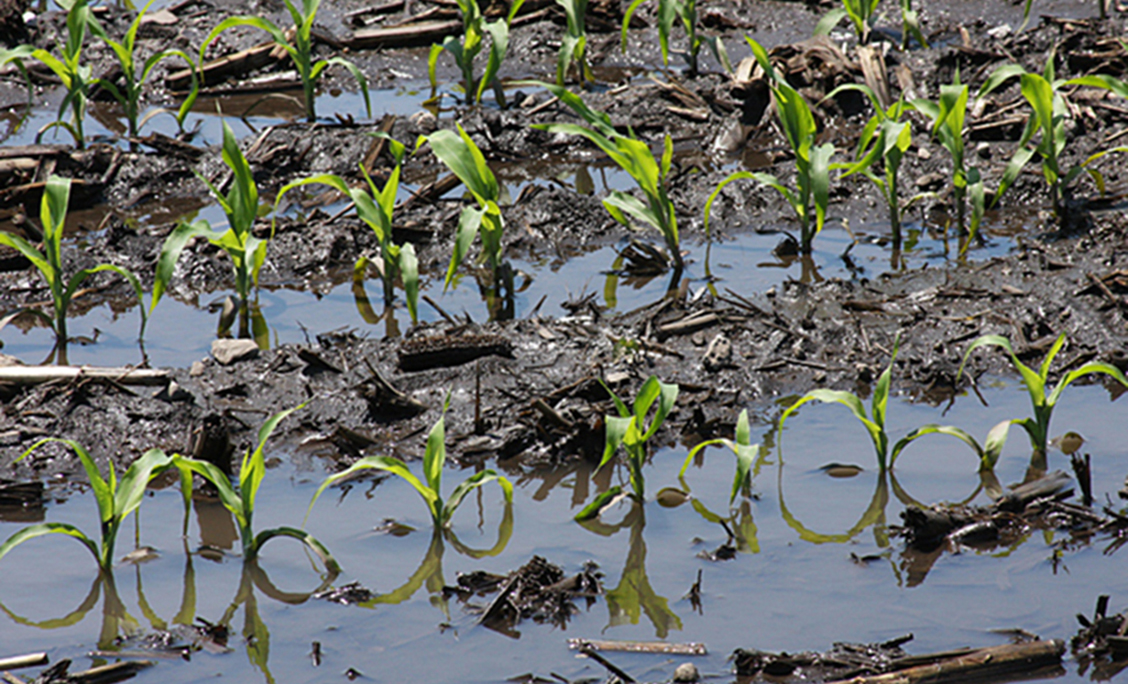Each year there are a few acres replanted somewhere due to adverse environmental conditions. The replant decision must be made by weighing the production of a replanted crop versus the production of the damaged field if left untouched.
It’s easy to let emotions influence a replant decision, but it’s important to make the decision based on logic and economics. Wyffels has developed a Replant Calculator that will help take emotion out and let the facts drive the decision.
If the decision is made to replant, there are a few factors you must consider to ensure maximum yield potential. Replanting presents some unique challenges, but with proper planning they can easily be overcome to set the replanted acres up for success and increase profitability.

PLANT STAND DETERMINATION
The first step in a replant decision is to evaluate plant stands in the damaged areas. In cases of hail, flooding, or freeze damage, it’s best to wait at least 5 days after damage occurs to allow plants time to recover.
It’s important to only count healthy, productive plants. Plants with discolored growing points, and plants more than one leaf behind neighboring plants will not produce productive ears, so they shouldn’t be counted. Uniform plant spacing is also an important consideration as multiple large gaps in the stand will greatly reduce yield potential.
PLANTING DATE YIELD POTENTIAL
Another important consideration is to compare the yield potential of the current stand at the original planting date versus the yield potential of the expected replant stand at a later date. The ideal planting date varies by geography, but there will be a yield penalty for the replanted stand relative to the original stand. The decision is based on whether the benefit of the improved stand will outweigh the penalty of a later planting date.
WYFFELS REPLANT CALCULATOR
To assist with replant decisions, Wyffels has developed a Replant Calculator which walks through all the factors that should be considered in the decision. It’s easy to let emotions influence a replant decision, but this tool will help you assess the situation from a logical and economic standpoint in order to make the best economic decision for each specific field.
HYBRID MATURITY
A common question is whether to switch to earlier maturing hybrids when replanting. If the entire field is being replanted it is best to stick with your original relative maturity up until at least the end of May. That hybrid was likely chosen for that environment because it best fits the geography, soil type, pest pressure and other factors of that field. Up until then the benefits of that placement outweigh any considerations of changing relative maturities. It’s also been documented that later-planted corn requires fewer growing degree units (GDU) to reach maturity than corn planted earlier.
If a partial field is being replanted and it’s important to keep harvest moisture similar throughout the field, earlier hybrids can be chosen. To choose the best hybrid for this application, reference the GDU to black layer for each hybrid and consult your Wyffels Seed Representative to determine the best Wyffels product for your situation. You can also use the Wyffels GDU Calcuator to give you predictions of black layer timing for different hybrid options. As hybrids are planted later in the year they adjust the number of GDU needed to reach maturity, and the Wyffels GDU Calculator automatically incorporates that adjustment.
REMOVING CURRENT STAND
It can be tempting to “spot in” corn in areas with lower stands, but this isn’t recommended as plants from the two planting dates will compete with each other. It’s also very difficult to know where to start planting and where to stop. The best way to replant corn is to eliminate the original stand and start anew. If you’re planning to use a herbicide for crop removal, always read and follow the herbicide label. Here are some ways to remove the current stand.
- Tillage – Most effective on emerged plants. Work the field at an angle to the original rows and make sure the implement is set deep enough to tear out the plants completely. Ensure the field conditions are fit, otherwise you might do more harm than good.
- Roundup® (glyphosate) – Very effective at killing corn that doesn’t contain a glyphosate resistance trait. In the Wyffels lineup the only hybrids that don’t contain a glyphosate trait are non-GMO hybrids.
- Liberty® (glufosinate) – Effective herbicide to kill corn that does not contain a glufosinate resistance trait. In the Wyffels lineup, Liberty could be used to kill RR2, VT Double PRO®, Trecepta® or non-GMO hybrids.
- Postemergence “grass” herbicides – Some postemergence grass herbicides have residual activity and will damage replanted corn. Check the herbicide label. For example, the clethodim (Select Max® and others) label states that corn can be replanted 6 days after application, but the quizalofop (Assure® II and others) label has a 120-day plant back restriction for corn.
INSECT PROTECTION
Replanted fields will be very attractive to second generation corn borer moths and will be more susceptible to rootworm damage because the corn will be smaller when the rootworms hatch and begin to feed on roots. So, hybrids with corn borer and rootworm traits are recommended. Very few soil insecticides are labeled to be used twice in one season, so they are usually not an option.
OTHER CONSIDERATIONS
-
Crop insurance – Many crop insurance policies have specific requirements for replant situations. Be sure to check with providers to ensure policy compliance.
-
Replant costs – This includes seed, fuel, labor, loan interest, removal of the original crop, and potential extra grain drying.
-
Herbicide and insecticide – Understand the implications of any pesticides that were applied with the original planting. In some cases, re-application is not necessary or permitted.
CONCLUSION
The decision to replant a corn crop is often a hard one to make. But once the decision is made there are a few steps you can take to set yourself up for success. When the aim is to preserve top yield potential, the devil is in the details. Consider all of the factors and make the decisions that are best for your specific situation.
